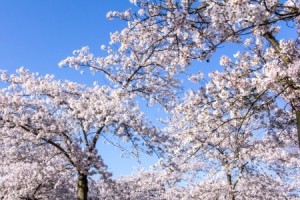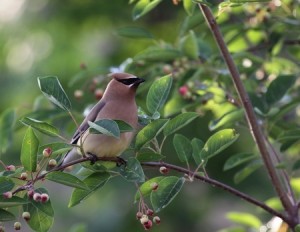
Spring cloud of serviceberry flowers
Serviceberry (Amelanchier spp.) is unquestionably a personal favorite of mine. An easy-to-grow small native tree that will produce berries delicious enough to bake in a pie. If you’re looking for beauty and functionality in a small landscape tree, serviceberry is a smart selection.
Serviceberry flowers expand prior to the leaves. The delicate white flowers are short-lived, but they put on an eye-pleasing performance that attracts early pollinators. The tree is also known as Juneberry, as the bright red berries mature in late spring or early summer.
Wildlife Food

Cedar waxwing dining at The Serviceberry Cafe
Serviceberry is a native plant and a boon to both caterpillars and the birds who eat those caterpillars. Mockingbirds, American robins, cedar waxwings and squirrels will compete vigorously for these delicious fruits. Mockingbirds, finding the berries irresistible, will defend them with great vigor. But their clever opponent and nemesis, the American robin, will surreptitiously steal berries at the slightest slip in the mockingbird’s guard, which usually occurs when the anxious mockingbird gives chase to a shoplifting squirrel.
If you enjoy watching wildlife, plant a serviceberry. It will bring a fortnight of high-stakes aerial avian combat, the ornithological equivalent of World War II dogfighting.
But don’t leave all the berries for the wildlife, harvest some for your family. Serviceberries taste excellent, perhaps comparable to blueberries. I enjoy them over a bowl of cereal and I’ve been told they make delicious jams and jellies.
Landscape Value

Autumn colors of serviceberry
Serviceberry has year round interest. Beautiful spring star-shaped flowers, red to purplish summer berries, spectacular red-orange fall color, and an intricate pattern of limbs during winter.
They have very few insect and disease problems. Occasionally some of the berries will be diseased by a cedar rust, but afflicted berries are usually easy to remove by hand.
It’s best used in a naturalistic planting with an evergreen background. Serviceberry is a small slow growing tree that will usually remain under 30 feet tall, but often it will be equally as wide. It can be trained as a single stem specimen or you can keep it pruned small as a multi-stemmed shrub. You can view a tall (64 ft.) Amelanchier laevis in the Virginia Big Tree Database.
Look for Amelanchier ×grandiflora ‘Autumn Brilliance’ if you want a dazzling display of fall color. We would be happy to install one or several for you. Enjoy your landscape more by installing native plants that are both attractive and beneficial to local wildlife.

Very informative overview of the serviceberry! The Elizabeth Park Garden Club looks forward to your May presentation.
Hi Linda, I’m looking forward to meeting your garden club members. It’s always enjoyable to speak about a subject where individual gardeners can make a difference. Sustaining wildlife with native flora can make a positive impact on local biodiversity one plant and one garden at a time.